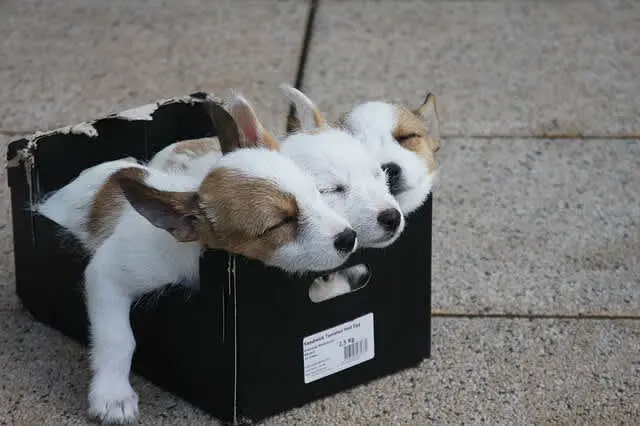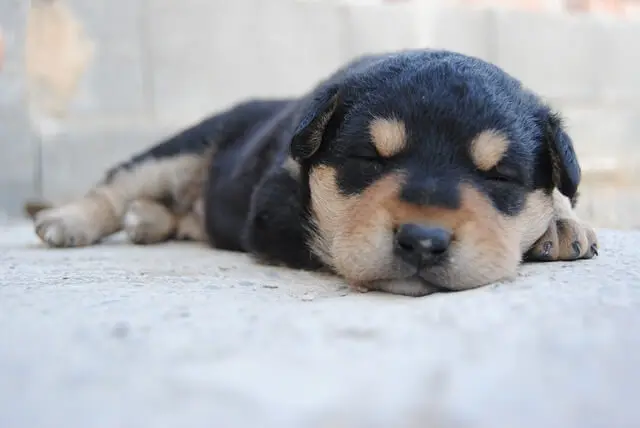Crate Training Puppy Guide – Puppies Indoor Kennel

Easy Puppy Crate Training
Puppy crate training or using a crate is not cruel – it can have great benefits. However, leaving a dog locked up in one 24/7 is! That is not what they are intended for. Some pups take to it straight away, but others need to get used to the idea. If the breeder has introduced the pup to a crate at an early age, you are halfway there. These tips may help.
What kind of crate for my puppy?
Most crates are metal wired and collapsible so they can be easily stored or transported. You can also buy hard plastic crates and soft fabric ones. These are generally used for travel and not recommended for daily use. The crate needs to be large enough for your whelp to stand up, turn around and stretch out comfortably. Always allow some growth room but don’t get one too large. Crates can be a good aid for toilet training as pups as a general rule, do not like to soil their bed. However, too large a cage could encourage them to use one end as a toilet! Accidents can happen during toilet training so its good to have a washable dog bed in case. Some crates have dividers which allow the cage to be enlarged as the pup grows which can be very helpful at this stage of the pups life.
What is the purpose of the crate?
Canines naturally like to have enclosed places to sleep. They often like to find security under a table, in a corner or under a bush in the garden. A crate can provide a place your dog can retreat to when he has had enough excitement for one day. A place where he will feel secure and happy when home alone. Eventually, the pup will acknowledge that the crate is his space and will voluntarily go to it happily. The crate should never be used as a punishment. Used and introduced properly, the crate can be a dog owners best friend. Travel crates are also great for the car if you have a pooch that will not readily settle on journeys. It is not safe and very distracting to have a dog jumping around in the car.
How to introduce the crate
Find a place to set up the crate where it will stay. There may be a time when you no longer need to use it, but you will find that your dog will still use that spot to sleep! You can replace the crate with a dog bed. If you have the space and something suitable to create an enclosure around the crate, all the better. That would allow the crate door to be kept open and give extra space to wander. Keeping young mischievous pups out of harm’s way and your furniture and loose wires in tact!
Make the crate as cosy as possible with a crate mattress or suitable dog bed and blanket. It’s best to source a good quality waterproof cage mattress.
These are all suitable for a crate and come in different sizes and thickness. They are made from tougher fabric and are easy to keep clean. They are usually fully washable or ok to hose down if there are any accidents.
Puppy crate training tips
Put in some puppy toys for play and stimulation. Don’t forget to regularly take puppy outside for toilet every hour or so, especially after food. Always keep the door open at all times until the pup is voluntarily going to the crate. When sleeping in the crate, the door can be closed for short periods and opened again once the pup is awake. Start with short periods and gradually build up time. Never close the door on a puppy younger than 12 weeks for long periods. It is unlikely your furbaby at that age will have full bladder and bowel control and could become very distressed. Always allow many trips outside to toilet. Unfortunately, that may mean some disturbed nights sleep for a few weeks!
Allow pup to rest and sleep in the crate in between his exciting agenda of play, socialisation and starter training. He will soon begin to acknowledge the crate as his ‘space’. When the time is right close the crate door and leave the room out of sight. Do this for a few minutes at a time and build up the length of time you are out of sight. This way separation anxiety may be avoided when you do leave the house and leave him home alone. It is not recommended at any time to leave a young dog restricted in a crate for longer than a couple of hours unless overnight.
Clicker training can be started with a puppies as young as 12 weeks. Getting your pup used to the clicker sound early on is a good idea. Pups usually find this fun and consider it a game.
Ten Top Puppy Training Tips – Do’s and Don’ts
1. Don’t buy a cage too large unless it has dividers to enlarge as puppy grows
2. Do make it cosy using a waterproof crate mattress and blankets
3. Do provide toys and chews to keep your pup entertained
4. Don’t close the cage door on your pooch until he is totally acclimatised and happy to be in it
5. Do create the use of the crate as a place of safety and security
6. Don’t use the crate as a form of punishment for bad behaviour
7. Do consider using a travel crate if your young dog does not settle in the car
8. Don’t encourage soiling in the crate by leaving your puppy for too long periods
9. Do remember to take your pup out for regular toilet breaks, even at night
10. Don’t expect too much too soon. It can take a while for a pup to get used to being on its own.
Paws Plus offers a large selection of dog care products including training aids to assist all dog owners. Good luck training your young dog!


